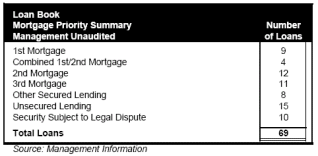Details of Bridgecorp gloom
The report presented by Bridgecorp's receivers on the state of the collapsed company is extremely different to the one the failed finance firm's management were telling advisers recently.
Thursday, August 2nd 2007, 8:56AM
In their report the receivers, John Waller and Colin McCloy from PricewaterhouseCoopers, said there were 69 loans with a total book value of $393 million.
They point out that Bridgecorp was lending mainly on property development in three jurisdictions; New Zealand, Australia, and Fiji.
With most of the loans interest was accrued and paid out at the end, rather than being paid in monthly or quarterly intervals.
This tends to support the view that the company was managing its interest payments to investors on new money being invested.
One of the revelations in the report is that a large proportion of the loans where second or third ranking mortgages and some were even lower ranking.
"The practical effect of this is that often when loans are in default, the receivers are unable to enforce security on the loans without the consent of prior ranking mortgages.
This limits the options open to receivers in attempting to recover individual loans," the receivers say.
 As the table shows there were just nine first ranking loans and four which were combined first and second mortgages.
As the table shows there were just nine first ranking loans and four which were combined first and second mortgages.
Also the receivers confirmed what had been discussed in the market; that is many of the better quality loans had been sold to other financiers to generate cash flow for principal and interest repayments.
One of the key selling points of some Bridgecorp debentures was their principal insurance with Lloyds of London.
The receivers say that these policies are unlikely to provide as much protection as investors may have thought.
"Not all loans qualified for insurance and the level of insurance recoveries is not significant when compared with the overall size of the loan book."
Depositrates.co.nz understands that there were limits on the type of loan covered, the total amount that could be claimed and that loans had to meet certain criteria in terms of loan-to-valuation ratios and priority ranking.
While the loan book sat at $393 million the total assets of the firm were recorded by management as being $595.3 million. The next two biggest assets were intergroup advances of $87.54 million and accounts receivable of $60.78 million.
The receivers say indications are that intergroup advances will not be fully recovered, particularly because some of Bridgecorp's Australian companies have also collapsed.
Accounts receivable includes $51.1 million in respect to Fiji developments and this looks difficult to recover.
Overall Bridgecorp had 14,500 secured debenture holders owning around 19,000 investments with the company.
The report this week relates just to the debenture holders. A separate report will be issued for those who invested in the company's capital notes.
As reported earlier the receivers have given a wide range of what investors may get back – it could be anywhere between 25c and 74c for each dollar invested.
The receivers have split the company's loans into two groups, New Zealand loans and the other group has specific Australian, Fijian and other offshore loans.
With the former group the receivers predicting the recovery will be between 25 and 40% on a total amount lent from investors of $458,738.
The receivers say it is very hard to predict what level of recovery there will be from the offshore loans because of the complexity of the transactions, the current state of the projects and the political uncertainty in Fiji.
| « Bridgecorp receivers have bad news for investors | Banks battle over one-year rates » |
Special Offers
Commenting is closed
| Printable version | Email to a friend |


